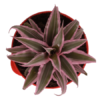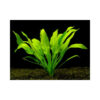Because of its large size, simple yet magnificent appearance, and low care requirements, the Amazon Sword plant (Echinodorus amazonicus) is a popular aquarium plant. This plant can grow to a height of 20 inches with proper lighting and water quality. It is classified as a Rosette plant because of the way its stems and leaves are formed, which are distinguished by their extremely short stem axes and the way their leaves grow upward from the plant’s base.
The plant’s name comes from its sword-shaped leaves, which range in colour from pale to dark green. This plant is ideal for use as a background plant in a large aquarium or as a stunning centrepiece in a small aquarium due to its wide leaves. This plant grows as a bare root cluster with 5 to 10 leaves. This plant requires no special or intense lighting and can be kept in any freshwater tank. Our Amazon Swords, like all of our plants, are stored in water in a dedicated tank rather than plastic packaging, resulting in a much healthier plant.
The Amazon Sword is a well-known and tried and true aquarium plant from tropical South America. Its leaves are significantly narrower than those of E. grisebachii ‘Bleherae.’ This Echinodorus wild type requires little care, but medium light intensity and a nutrient-rich substrate are recommended. Echinodorus grisebachii ‘Amazonicus’ forms a large, noticeable rosette with numerous leaves. It is especially recommended for large tanks containing, for example, Discus or angelfish (Pterophyllum). The swordplant leaves are frequently used as a spawning ground by the latter.
The Amazon sword, Echinodorus grisebachii ‘Amazonicus,’ is also known as Echinodorus amazonicus. It is a member of the species Echinodorus grisebachii, which is widely distributed in the American tropics and known for its many varieties. This species also includes E. grisebachii ‘Bleherae’ and E. grisebachii ‘Parviflorus.’
First, this plant was introduced to the market in 1938, under the incorrect name “”E. brevipedicellatus”” (a synonym of Echinodorus longipetalus). It was long known by that name. Karel Rataj described it as a new species only in 1970. (E. amazonicus). It was discovered growing submerged in 50 to 100 cm deep stagnant to slow-flowing water in the Brazilian Amazon depression (Rondônia and Pará).
Typically, forms of E. grisebachii that are very similar to E. grisebachii ‘Parviflorus’ and ‘Bleherae’ are marketed as E. amazonicus. When grown submerged, these plants can reach a height of about 40 cm. The original type of E. grisebachii ‘Amazonicus’ was popular in aquaristics decades ago and differs significantly from those now available. When grown submerged, it develops very narrow, lanceolate leaf blades that curve sideways like a sickle. It can grow to over 60 cm in height in the aquarium, similar to E. grisebachii ‘Bleherae,’ but differs primarily in its narrower leaf form.
Submerged plants that are growing well sprout 1 to 2 new leaves per week and frequently develop long flower stalks with adventitious plants floating below the waterline.
This is a very simple plant to propagate because it produces new roots or runners, so to get more plants from it, simply cut two separate plants that grew from one, and these will then generate into new plants. When re-planting, make certain that the pieces are not completely submerged in the substrate. These can also be grown from seed, but it takes a lot of patience and care. The Sword should be partially submerged rather than completely submerged; this method will allow the Sword to produce a flower stalk that can be self-pollinated with a fine brush; the pollen, as expected, will be yellow in colour and can be brushed all over the flower heads. A seed pod will form over time, but it may appear inactive for an extended period of time. Be patient, and the pod will eventually produce seeds that can be planted like other aquatic plants, resulting in the formation of new plants.
Simple if the proper water conditions are provided. They prefer softer water, whereas other Sword species thrive in harder water.
They are one of the most popular aquarium plants because they are hardy and require little care. Once settled, they should develop a strong root system in the aquarium and can grow quite large, so give them plenty of room. The Amazon Sword can provide a lot of cover in larger aquariums by adding 2-3 specimens, but as they mature, they can grow leaves that can reach up to 12 inches in length, so adding these to a small aquarium can quickly crowd a tank, restricting swimming space for the fish themselves. When first added to a new setup, you may notice algal blooms on the Sword’s leaves, but if the water quality is good and the parameters begin to settle, these blooms should disappear as quickly as they appeared. Yellowing of the lower leaves is a sure sign of nutrient deficiency, so keep an eye out for it and add liquid fertilisers to the water to remedy it.
How should echinodorus be cared for?
Plant Echinodorus in a nutrient-rich substrate such as sand or aquatic plant substrate. Gravel is also an option. It should be deep enough for the plant’s hardy roots to travel to obtain nutrients. These plants will thrive if a root tab is planted beneath them.
Do sword plants grow quickly?
Because the Amazon Sword Plant leaves grow slowly, last a long time, and prefer bright light for long periods of time, they are prone to algae growth. If algae growth becomes a problem, it is not advisable to try to wipe it off the leaves because they may crack.
How do you cultivate Echinodorus Amazonicus?
Remove the plant from the pot and split the rockwool in half. Remove as much rockwool as possible. As much as possible, divide the plant into several portions and place them in your substrate.










Reviews
There are no reviews yet.